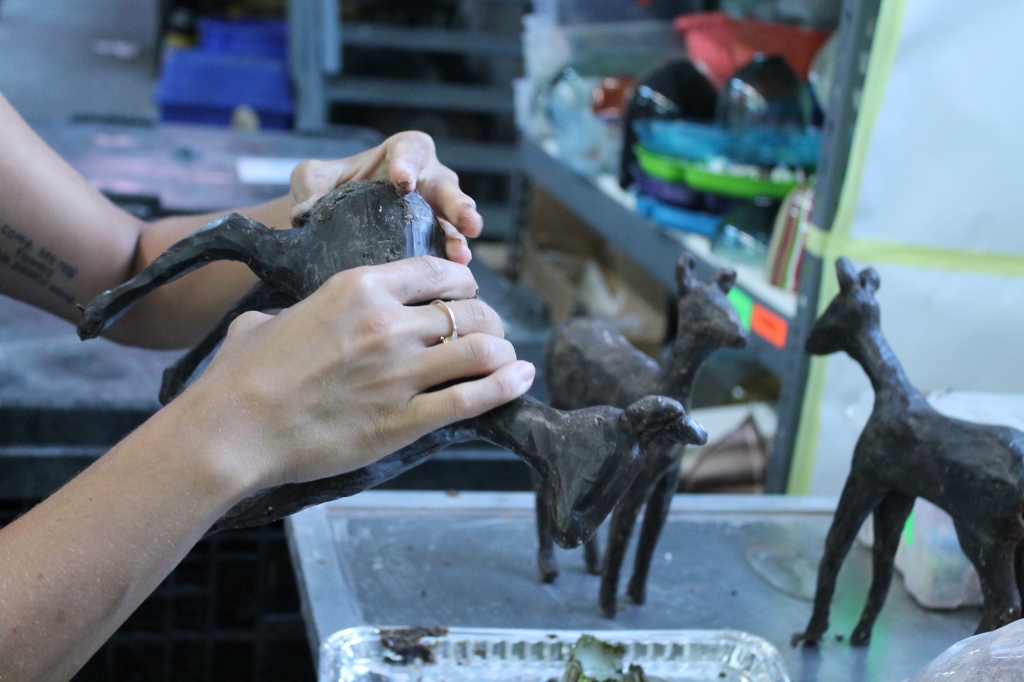 UrbanGlass artist-in-residence Alexis Callender prepares molds for her work on a kiln fired glass installation. photo: katharine morales
UrbanGlass artist-in-residence Alexis Callender prepares molds for her work on a kiln fired glass installation. photo: katharine morales
Glass happens to visual artists the way poetry happens to writers. It’s love (of a challenge) at first sight. It’s rare that one is born into it, as in the case of Lino Tagliapietra. More often, an accident happens in pursuit of a career in painting, architecture, or design and in it, a trajectory is redefined. Artists working in glass are like newly engaged couples who know exactly how to answer the eager question, “How did you guys meet?” In most cases, it is simply, “Through a friend of a friend.” Alexis Callender, the current artist in residence at Brooklyn’s nonprofit open-access glass center UrbanGlass (which publishes the GLASS Quarterly Hot Sheet), has her own unique love story with the material. Before receiving her two month residency at the studios of UrbanGlass, she had worked exclusively with paper.
After receiving her MFA from the Massachusetts College of Art and Design, Callender began her professional career as a painter. In art school, she was not exposed to glass as a medium for sculptural fine art. Not having an interest in the traditional, more functional glass art works she had come across, she pursued a residency last summer at the Public Art Academy in Pennsylvania. Callender’s foray into lands uncharted began with a ceramist friend watching her prepare relief stencils for the installation at this residency. The reliefs — animal bodies and natural forms — were weatherproofed which required several extra steps such as an epoxy layer. As her friend watched Callender prepare her installation the only way she knew how, she simply suggested there was a much easier way to do that. Using porcelain or clay forms, the weatherproofing would be inherent — she would just have to embrace an entirely new technique.
 Callender adds and subtracts bits of the mold for a re-firing. photo: katharine morales
Callender adds and subtracts bits of the mold for a re-firing. photo: katharine morales
Callender’s current focus revolves still around the ethereal flora and fauna she has cultivated in her singular voice. While considering the possibility of various new mediums, there was something not quite right about the ochre and texture of clay for the new project she had planned. Looking for open residency calls on NYFA’s website, she stumbled upon the UrbanGlass residency. The posting specifically stated the artist applying for their residency need not be familiar with glass production. “All of a sudden it kind of clicked,” says Callender, “Glass. That makes sense.”
At any point during the day, one can wander through the UrbanGlass studio and witness artists engaged in varying stages of a seemingly mystical process. I mention this to Callender, and while she agrees to a point, she has transformed her role from the mystified to the mystical in a matter of weeks. Expertly carving her wax molds of precious and shy looking deer with a blade heated over an holiday candle, she admits, “It seems like glass is so specific, that it’s not something you can sort of wander in and out of.” With the help of artist Jane Bruce and UrbanGlass studio director Brian Kibler, she has broken her own rule. Experiencing the relationship between artist and materials in a brand new way has been, “Awesome. I don’t know what’s wrong, and there’s a freedom in that.” In a career expanding path reminiscent of Ann Wolff (an artist with whom Callender is refreshingly unfamiliar) the relationship she has forged with glass constantly references her paper-sculpting background.
 Urban Glass artist in residence Alexis Callender prepares molds for her work on a kiln fired glass installation: photo: katharine morales
Urban Glass artist in residence Alexis Callender prepares molds for her work on a kiln fired glass installation: photo: katharine morales
Translating her work into glass allows her to maintain parts of the process such as the layering of molds, the spatial relationship, the stopping, starting and re-working. “The way I make work,” she says, “I love process and this is such a process. Going through each step and watching the additions and reductions in the process of making my molds and translating them into glass. You make a mold that you can change every time. So now I’m free sculpting the mold I made which is something I never expected I would be able to do.”
As refreshing as the process is for Callender’s new body of work, there is never enough time to re-work, refresh and recalibrate in the way an artist needs. Halfway through our conversation, we are interrupted briefly but urgently by Bruce. Apparently there is a slumping conflict of interest, and it seems that the more Alexis can get fired today, the better it will be for business. Her residency position is only two months long, and the “firing schedule” being passed around seems to be a constant reminder that her days as an emerging glass artist are not, at this point, endless. At every turn they realize there are more molds to coordinate with another of Alexis’ frit drawings with an open-access studios sharing of kiln time.. Hearing someone who, 6 weeks earlier, had never poured a glass mold throw around words like “slumping” and “frit” is still rather impressive. And the entire experience, whether she continues to work with glass after the residency, provides a lesson valuable to artists of every stripe — ardent time management.
“In paper there’s this last minute jump. But when you’re firing things you have a schedule to keep. You can’t just not sleep for two days and get this thing done because that’s not the way glass falls,” says Callender.
—Katharine Morales


